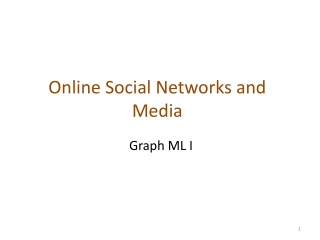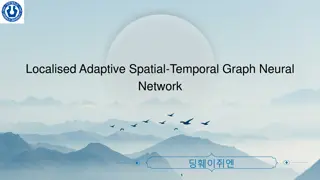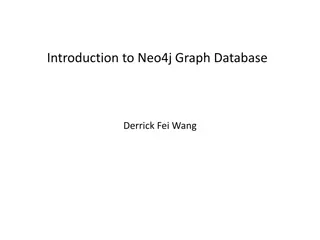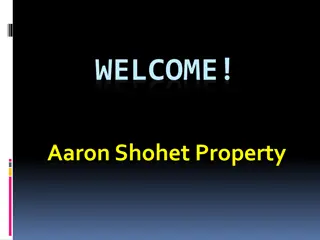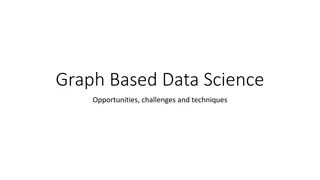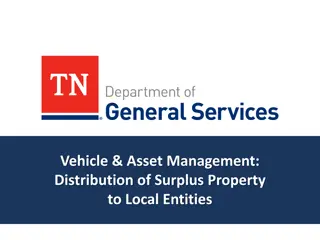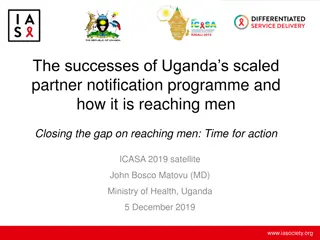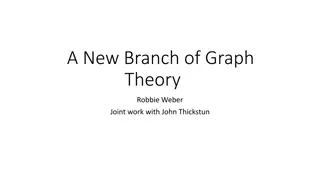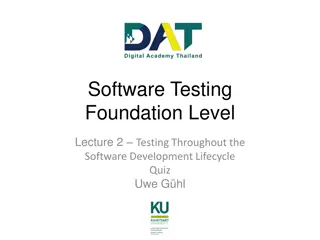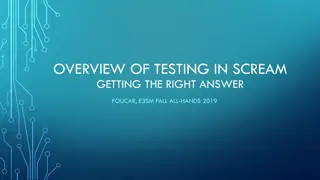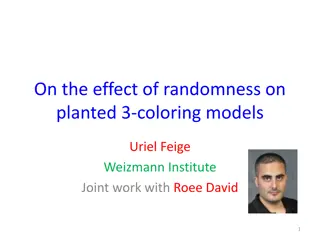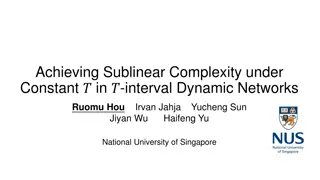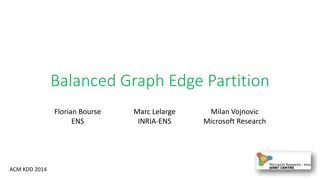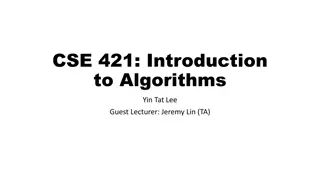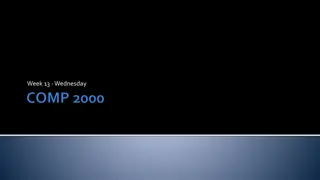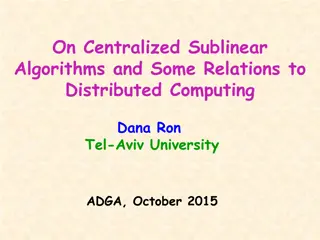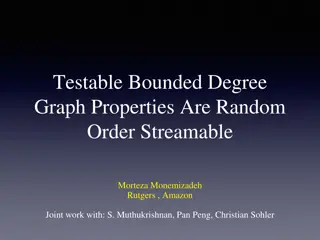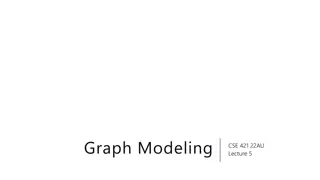Sublinear Time Models for Graph Property Testing
Dive into the world of property testing with sublinear time models for graph properties. Explore concepts like distance between graphs, adjacency predicates, and incidence functions. Understand how testers can be transformed into more realistic models using arbitrary vertex sets and distributions.
Download Presentation

Please find below an Image/Link to download the presentation.
The content on the website is provided AS IS for your information and personal use only. It may not be sold, licensed, or shared on other websites without obtaining consent from the author.If you encounter any issues during the download, it is possible that the publisher has removed the file from their server.
You are allowed to download the files provided on this website for personal or commercial use, subject to the condition that they are used lawfully. All files are the property of their respective owners.
The content on the website is provided AS IS for your information and personal use only. It may not be sold, licensed, or shared on other websites without obtaining consent from the author.
E N D
Presentation Transcript
Testing Graphs in Vertex Vertex- -Distribution Distribution- -Free Free Models Oded Goldreich Weizmann Institute of Science Offer: 100USD for an alternative name that is adopted by me. And I ll be happy to pay. (Expires: July 14th, 2019.)
Property Testing = Sublinear Time Approximate Decision Sublinear time Direct access to the input (oracle) Approximate Decision = Distinguish objects in the set from objects far from the set. Distance between objects (typically, relative Hamming distance) + A proximity parameter Tester = sublinear-time approximate-decider. Often focus on its query complexity.
The standard models of Testing Graph Properties The vertex set is [n], and n is given as input to the tester. The tester is given oracle access to the graph. Distance between graphs = (fractional) Hamming distance between corresponding oracles. The adjacency predicate (dense graph) model graph G=([n],E) oracle f:[n] [n] 0,1 Dist(G,G ) = | (u,v) [n] [n]:f(u,v) f (u,v) |/n2 The incidence function (bounded-deg graph) model graph G=([n],E) oracle g:[n] [d] [n] 0 Dist(G,G ) = | (v,i) [n] [d]:g(v,i) g (v,i) |/dn The vertex set is fully specified by n, and this allows for uniformly sampling it. d = the degree bound
Make it more realistic: Step 1 = arbitrary vertex set [G18] The vertex set is an arbitrary set V, and the tester is given |V| as well as a device that samples V uniformly. The tester is (also) given oracle access to the graph (as before). Distance between graphs (as before) = (fractional) Hamming distance between corresponding oracles. The adjacency predicate (dense graph) model graph G=(V,E) oracle f:V V 0,1 Dist(G,G ) = | (u,v) V V:f(u,v) f (u,v) |/|V|2 The incidence function (bounded-deg graph) model graph G=(V,E) oracle g:V [d] V 0 Dist(G,G ) = | (v,i) V [d]:g(v,i) g (v,i) |/d|V| All (standard model) testers* can be transformed to this model, since they only use their knowledge of V in order to determine |V| and to uniformly sample V. *) That is, all I can think of . And if you allow some overhead then actually all.
Make it more realistic: Step 2 = arbitrary distribution on the vertex set The vertex set is an arbitrary set V, and for an arbitrary distribution D, the tester is given a device that samples V according to D. (Definitional choice: The tester is not given |V|.) The tester is (also) given oracle access to the graph (as before). Distance between graphs = D-induced weighted distance between corresponding oracles. The adjacency predicate (dense graph) model graph G=(V,E) oracle f:V V 0,1 Dist(G,G ) = Probu,v D[f(u,v) f (u,v)] The incidence function (bounded-deg graph) model graph G=(V,E) oracle g:V [d] V 0 Dist(G,G ) = Probv D,i [d][g(v,i) g (v,i)] The graph exists explicitly in reality (e.g., physical, biological, digital) The graph is defined by an (adjacency or incidence) oracle that exists in reality.
Our results (1): The role of one-sided error. Focus on strong testability = query complexity that depends only on the proximity parameter (obliviously of the graph and distribution). One-sided error tester: Always accepts graphs that have the property (i.e., no error here), and rejects w.h.p. graphs that are far from it. In both (dense and bounded-degree graph) VDF models, strong testability implies strong testability with one-sided error probability. In the dense model: query complexity is quadrupled. In the BD model: query complexity is exponented. Corollary: Only properties that are strongly testable with one-sided error in the standard model, can be strongly tested in the VDF model. In both cases, the necessary condition is not sufficient.
Our results (2): Some positive results. Focus on strong testability = query complexity that depends only on the proximity parameter (obliviously of the graph and distribution). In the dense graph model: Strong testability for two classes. 1. General Graph Partition Prop s that sat. the necessary condition. 2. Subgraph-freeness properties. Via direct adaptation of the standards model testers of [GGR, AFKS]. In the bounded-degree graph model: Strong testability for a few properties (e.g., subgraph-freeness, degree-regularity, being Eulerian, containing no tree with k leaves).
Show something technical (actually, why?) strong testability = query complexity that depends only on the proximity parameter (obliviously of the graph and distribution). One-sided error tester: Always accepts graphs that have the property (i.e., no error here), and rejects w.h.p. graphs that are far from it. THM: In both (dense and bounded-degree graph) VDF models, strong testability implies strong testability with one-sided error probability. PF (for dense model): Let T be a general tester of query complexity q for property . Then: Take a sample of O(q2) vertices, denoted S, from the distribution D. For each choice of 2q vertices from the sample, and random-tape for T, invoke T with that tape, and answer its queries using these vertices. Decide according to the majority verdict. If G is in , then, for each S, tester T should accept whp on Unif(S). No error on G . If G is far, then T should reject on D. A random 2q-subset of S behaves as a 2q-sample of D. Wlog, T queries the subgraph induced by 2q random vertices. N.B.: Our tester tosses no coins. Its randomness is due to the choice of S.
Proving the Theorem in the bounded-degree graph model strong testability = query complexity that depends only on the proximity parameter (obliviously of the graph and distribution). One-sided error tester: Always accepts graphs that have the property (i.e., no error here), and rejects w.h.p. graphs that are far from it. THM: In both (dense and bounded-degree graph) VDF models, strong testability implies strong testability with one-sided error probability. PF (for BDG model): Let T be a general tester of query complexity q for property . Then: Take a sample of O(q2) vertices, denoted S, from the distribution D. For each choice of q vertices from the sample, and random-tape for T, invoke T with that tape, and answer its queries using these vertices. Decide according to the majority verdict. Query complexity: |S| exp(q) = exp(q). Wlog, T sample at most q vertices, and explore vertices at distance at most q from them. N.B.: Our tester tosses no coins. Its randomness is due to the choice of S. (In the dense graph model it was |S|2.)
Obtaining VDF testers for the dense graph model (general graph partition prop. and subgraph freeness) Tester: Invoke the standard tester T on the input graph G, while presenting possible repeated samples of a vertex as distinct vertices. (Vertices represented copies of the same vertex are not incident to one another.) Analysis: Mental experiment in which T is invoked on imaginary G that is obtained from G by a weighted blow-up, where a vertex v of weight D(v) is replaced by a cloud of size D(v) N. No problems with k-Colorability and triangle-freeness, but For general graph partition properties: If a vertex of G should appear in a clique (of the k-partition), then its copies should be connected by edges. Try all possibilities for heavy vertices. For general subgraph freeness: A forbidden copy of the subgraph in G may not contain copies of the same vertex. Use a generalization of subgraph freeness to edge colored graphs.
END Paper available from my homepage http://www.wisdom.weizmann.ac.il/~oded/ (see http://www.wisdom.weizmann.ac.il/~oded/p_vdf.html) Slides available at http://www.wisdom.weizmann.ac.il/~oded/T/vdf.pptx Recall my offer: 100USD for an alternative name that is adopted by me. (Expires: July 14th, 2019.)


